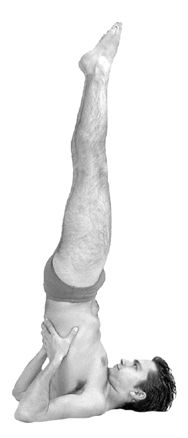Sarvangasana
Sarvangasana (Sanskrit: सर्वाङ्गासन; IAST: Sarvāṅgāsana), or Shoulder Stand, is a yoga asana in which the practitioner balances on the shoulders. It is known as the "Queen of asanas" due to its numerous health benefits. The name comes from the Sanskrit words Sarva meaning "all", Anga meaning "limb", and Asana meaning "posture" or "seat". This asana involves the body being completely inverted and supported by the shoulders, arms, and neck while the legs are pointed upwards. It is an integral part of Hatha Yoga and is considered a vital pose in modern yoga as exercise.
Benefits[edit | edit source]
Sarvangasana is reputed to benefit the functioning of all the body's systems. It is said to stimulate the thyroid gland, strengthen the immune system, improve circulation, and enhance mental clarity. By inverting the body, it also helps in relieving stress and reducing fatigue. Regular practice is believed to improve digestion, alleviate symptoms of menopause, and be beneficial for conditions such as asthma and sinusitis.
Technique[edit | edit source]
To perform Sarvangasana, one begins by lying flat on the back with legs together and arms by the sides. The legs are then lifted to a vertical position. Using the arms for support, the hips are lifted off the floor, and the spine is rolled up until the body is resting on the shoulders with the chin tucked into the chest. The hands are placed on the back for support, with the elbows close together on the floor. The legs remain straight and together, pointing upwards. The weight of the body should be supported by the shoulders, arms, and neck, not the head or spine. The practitioner breathes deeply while holding the pose for as long as comfortable, gradually increasing the duration with practice.
Precautions[edit | edit source]
Sarvangasana should be approached with caution by beginners or individuals with certain health conditions. It is not recommended for those with high blood pressure, heart conditions, neck injuries, or during menstruation. Pregnant women should avoid this pose after the first trimester. It is always advisable to practice under the guidance of a qualified yoga instructor.
Variations[edit | edit source]
Several variations of Sarvangasana exist, including Halasana (Plow Pose), where the feet are lowered behind the head, and Karnapidasana (Knee to Ear Pose), where the knees are bent and brought towards the ears while in Sarvangasana. These variations can intensify the stretch and offer additional benefits.
In Modern Yoga[edit | edit source]
Sarvangasana is a cornerstone pose in many yoga sequences and is particularly emphasized in Iyengar Yoga, where props such as blankets are often used to support the neck and shoulders. Its widespread practice is attributed to its comprehensive benefits and the belief in its power to harmonize the body and mind.
Navigation: Wellness - Encyclopedia - Health topics - Disease Index - Drugs - World Directory - Gray's Anatomy - Keto diet - Recipes
Search WikiMD
Ad.Tired of being Overweight? Try W8MD's physician weight loss program.
Semaglutide (Ozempic / Wegovy and Tirzepatide (Mounjaro / Zepbound) available.
Advertise on WikiMD
WikiMD is not a substitute for professional medical advice. See full disclaimer.
Credits:Most images are courtesy of Wikimedia commons, and templates Wikipedia, licensed under CC BY SA or similar.Contributors: Prab R. Tumpati, MD

